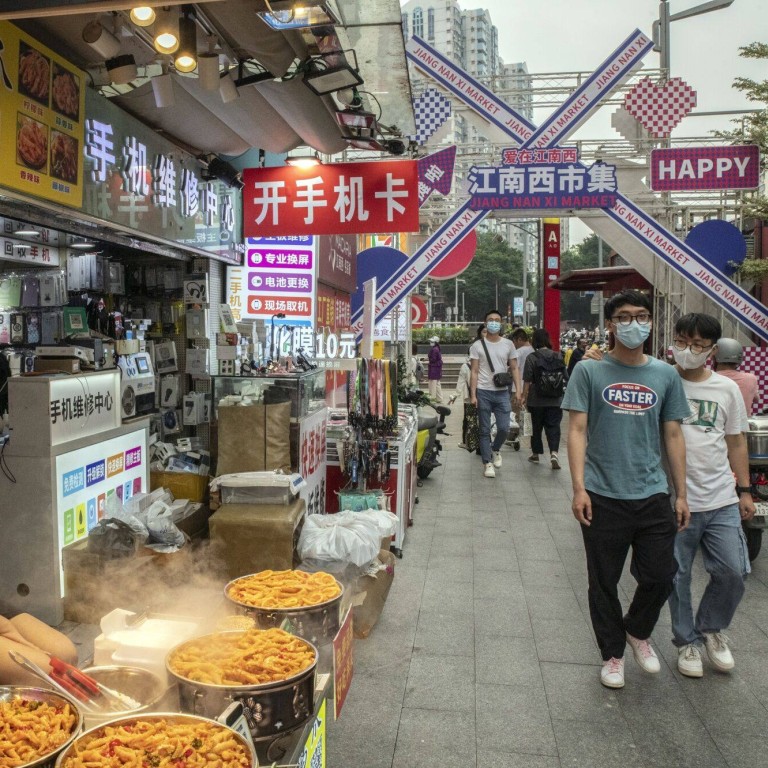
China’s consumer inflation slowdown, factory-gate price deflation enhances ‘great need’ for policy support
- China’s consumer price index (CPI) rose by 0.1 per cent in April, year on year, while the producer price index (PPI) fell by 3.6 per cent last month
- CPI hit its lowest rate in over two years in April, while PPI fell at the fastest rate since May 2020
China’s consumer inflation rose at its slowest rate in over two years in April, adding to concerns over weak domestic demand and economic uncertainty and enhancing the “great need” for further policy support, analysts said.
“The market’s fears of deflation are unnecessary since CPI is a more lagging indicator,” said Larry Hu, chief China economist at Macquarie Capital.
The producer price index (PPI) – which reflects the prices that factories charge wholesalers for products – fell at the fastest pace since May 2020 and was down for a seventh consecutive month after also missing expectations and falling by 3.6 per cent in April, year on year, down from a fall of 2.5 per cent in March.
China will still face a weakening domestic demand and a sluggish labour market, and there is a great need for further policy support
But according to Hu, other indicators show China is more likely to face a period of moderate inflation, with both CPI and PPI set to be low in the second quarter before rising in the second half of the year.
“However, China will still face a weakening domestic demand and a sluggish labour market, and there is a great need for further policy support,” Hu added.
But the month-on-month economic growth rate is likely to fall as China has passed the economic boom that followed its reopening, Hu said.
On Tuesday, Standard Chartered warned that China’s CPI may approach zero in the next few months as a crude-oil price spike in the first half of 2022 created a high comparison base.
The bank has lowered its forecast for China’s CPI in 2023 to 1 per cent from 2.3 per cent on tepid demand and falling pork and crude prices.
However, “with interest rates already at historical lows, and growth likely to comfortably beat the 5 per cent target, we do not expect the [People’s Bank of China] to cut policy rates in the foreseeable future”, its economists said.
Goldman Sachs also revised its forecasts due to weak domestic and external demand and falling crude oil prices, with CPI set to rise moderately and PPI to continue to deflate.
“Producer price deflation deepened further last month to a 35-month low, and consumer price inflation dropped to its smallest point in more than two years. Although reopening pushed up services inflation, this was more than offset by lower food and energy inflation, driven largely by base effects,” said Capital Economics.
“The labour market is tightening, which should continue to put some upwards pressure on services inflation over the coming months. But the government’s ceiling of around 3 per cent for the headline figure won’t be tested this year.”
China’s core consumer inflation rate, excluding the volatile prices of food and energy, rose by 0.7 per cent in April compared with a year earlier, unchanged from 0.7 per cent growth in March.
We believe the likelihood of a [People’s Bank of China] policy lending rate cut has been increasing, although it is not our baseline case
Within the CPI, food prices in China rose by 0.4 per cent from a year earlier in April, while non-food prices rose by 0.1 per cent last month, year on year.
Prices for pork, a staple on Chinese dinner tables, rose by 4 per cent in March compared with a year earlier, while fruit prices rose by 5.3 per cent, year on year, and vegetable prices decreased by 13.5 per cent.
Analysts at Nomura said they expect CPI inflation to “remain fairly soft in May”, although they added it may rebound to 0.3 per cent, year on year, due to a low base.
“We expect PPI inflation to drop further to minus 3.9 per cent year on year in May on falling global commodity prices. Given the low readings of both CPI and PPI inflation, we believe the likelihood of a [People’s Bank of China] policy lending rate cut has been increasing, although it is not our baseline case.”

